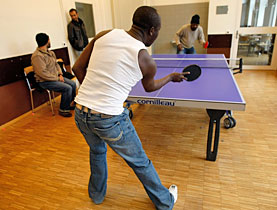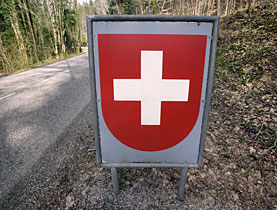Accident exposes world of Ecuadorian immigrants

The story of Mirta Palma, an illegal immigrant injured in a car accident, has highlighted the precarious world of clandestine Ecuadorians living in Switzerland.
It is estimated that there are up to 20,000 Ecuadorians in Switzerland, mainly in cantons Vaud and Zurich. Many live underground and choose not to regularise their status for fear of being expelled.
Palma, a 53-year-old single mother, has lived and worked in Lausanne since 2002 as a cleaner and cook, sending part of her earnings back to Ecuador to support her two young daughters. On June 26 she was doing her shopping in central Lausanne when she, together with eight other people, was hit by a runaway car.
Just a few days later while recovering in hospital after three operations to rebuild her crushed ankle and leg, the Ecuadorian received an official letter from the cantonal police stating she must leave the country by September 15.
The police had uncovered her illegal status while carrying out an investigation into the accident.
Her lawyer, Jean-Michel Dolivo, said the authorities’ attitude was “extremely shocking and unacceptable”.
“It’s a heartless act by the authorities as the threat of being expelled adds to the trauma and psychological shock,” he told swissinfo.ch.
But Henri Rothen, head of the canton Vaud’s population service, denied it was inhumane.
“Indeed it’s bad luck, but being an illegal immigrant is still against the law,” he told Le Matin newspaper.
Palma has applied for a “humanitarian” permit, which is issued in exceptional circumstances, but the application process remains extremely tough.
A better life
Palma is one of thousands of Ecuadorians who left their country in early 2000 seeking a better life. Some 2.5 million now live abroad, compared with a national population of 14.5 million.
Of these, up to 20,000 are thought to live in Switzerland, 80-90 per cent illegally, in cantons Vaud (6,000), Zurich, Geneva, Basel and Ticino.
“Most people came en mass in 2001 after Ecuador formally adopted the dollar as the official currency in 2000, which had a catastrophic effect on the economy and employment,” Byron Allauca told swissinfo.ch.
Allauca, coordinator for the Association of Ecuadorians and Friends of Ecuador in Lausanne, had his own status regularised in 2003 after living illegally in Switzerland for 11 years.
Hypocritical
Freddy Enriquez, 36, and his wife Veronica, 35, have been in Switzerland for the past nine years. In 2000 a permit was not needed to enter the country.
Freddy, a trained electrician, started out washing dishes in a restaurant and his wife worked as a cleaner. Although neither has a resident permit, both have been officially registered by their employers. In 2002 Freddy’s boss encouraged the family to regularise their residency status, but they were turned down by Bern.
The couple say the Swiss authorities’ attitude is hypocritical.
“We only want papers to live without any stress. Our second life is here,” Veronica told Le Temps newspaper.
Dolivo agreed: “There is hypocrisy as the authorities know that they are working in sectors where the Swiss would not work, like cleaning, working in restaurants or hotels, or looking after the elderly.”
“They have no rights to social insurance or unemployment benefit. A certain number are ‘au gris’, or semi-legal, insured by their employers and some pay their taxes up front, but most have very precarious living and working conditions,” said the lawyer.
The Enriquez couple are also concerned for the future of their two children, Daniel, 10, and Roni, five, who both go to school.
Unless they are good enough to go to high school, the children’s Swiss education ends at 16. An apprenticeship is not possible, as they would need a residence permit.
“Daniel wants to be a doctor but I try to make him change his mind as he will certainly not be able to do his studies here,” said Veronica. “But we will stay here to pay his studies.”
Solution needed
Alluaca feels the authorities lack the political will to deal with illegal immigrants and the only option in the future is mass regularisation.
“Employers and authorities also have a certain responsibility as they have given people jobs and collected contributions. They need to find a solution,” he said.
But Philippe Leuba, head of the cantonal interior department, opposes the idea of mass regularisations.
“We cannot make this step for the ‘sans papiers’. They have to do the process individually,” he said.
At the federal level the current restrictive immigration policy and attitude towards mass regularisations is unlikely to change in the near future.
Life, therefore, goes on for thousands of nameless Ecuadorians.
“The simple things remain inaccessible: letting my kids go on a school trip; renting a telephone, getting a better job or passing your driving licence. We live in constant fear of having our papers checked and not knowing what will happen to us,” Cecilia* [name withheld] told Le Temps.
Simon Bradley, swissinfo.ch
The number of asylum seekers in Switzerland peaked at 48,000 applications in 1999, with the majority coming from Serbia and Kosovo.
In 2004, the government stopped welfare benefits to rejected asylum seekers and the number dropped to 14,250.
In 2006, 10,500 people sought asylum in Switzerland. Almost 20% were accepted. The Swiss voted in a referendum in the same year to tighten asylum legislation, turning down applicants that did not have a passport and doubling the length of detention for rejected asylum seekers to two years.
The government recommended the measures after releasing a report that estimated there were 300,000 illegal immigrants living in Switzerland, 9,000 of whom had jobs. Others were suspected of carrying out criminal activities.
The new laws were criticised by the United Nations. The Swiss Federal Administrative Court in 2007 overruled a clause that allowed the authorities to expel asylum seekers without identification within 48 hours.
In 2008 the number of asylum seekers in Switzerland rose to 16,606 applications, compared with 10,390 asylum applications in 2007. According to the Federal Migration Office, Switzerland does not have enough accommodation to meet the rise and cantons have to make emergency arrangements.
An asylum seeker who has lived in Switzerland for at least five years and who can prove that he or she is integrated into society is eligible for a residence permit on humanitarian grounds. A return to their country of origin is considered a case of extreme hardship.

In compliance with the JTI standards
More: SWI swissinfo.ch certified by the Journalism Trust Initiative













You can find an overview of ongoing debates with our journalists here . Please join us!
If you want to start a conversation about a topic raised in this article or want to report factual errors, email us at english@swissinfo.ch.